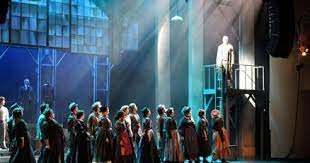University Opera Presents a Bloodless, Beautifully Sung “Sweeney Todd”
Stephen Sondheim has been on the collective minds of musical theater lovers a lot this year. Though he passed away at the age of 91 last November, his work is thriving. One of his first Broadway successes as a lyricist, “West Side Story,” has just been gorgeously reimagined on screen by Stephen Spielberg. And he makes a cameo in Lin Manuel Miranda’s latest project, the film version of “Tick, Tick, Boom.” (Bradley Whitford plays the composer, but it’s Sondheim’s voice on the answering machine, with words of encouragement for a struggling Jonathan Larson.)
Of course, devoted fans of Sondheim will tell you that his popularity and his importance in the canon has never waned. And when they list their favorite of his remarkable catalog, the epic, grisly tale of Sweeney Todd – the deranged London barber who killed his clients so his landlord Mrs. Lovett could serve their bodies in pies – is whispered in reverence. University Opera’s production of the musical thriller, Sweeney Todd, The Demon Barber of Fleet Street, convincingly demonstrates why the piece is held in such high acclaim.
Over three performances March 4-8, the cast of three dozen students – undergrads through doctoral candidates – brought the macabre tale to life with soaring, powerful voices that navigated Sondheim’s complex melodies and angular harmonies with ease. Lead parts were universally vocally strong, and a few performers infused minor characters with surprising depth and charm. When the chorus was ushered in from the wings to sing directly at the audience, it was like being bowled over with a wall of exquisite, purposefully discordent sound.
In the coveted title role, first year doctoral student Luis Orozco showed off his impressive range, sliding down to notes below the scale that practically made the theater vibrate. Already an accomplished performer with various opera companies around the world, his textured bass was a perfect accompaniment to the character’s dark obsession with revenge. As Sweeney’s morally challenged, baking partner in crime, Lindsay Meekhoff brought a devious glee to the role of Mrs. Lovett. Jealous of the cats that a rival baker was putting in her pies, Lovett was all too eager to improve her “Worst Pies in London” with ingredients no one else could stomach. Speaking and singing through a faux cockney accent as thick as black pudding, Meekhoff regularly overcompensated for a cast that barely attempted the lilt of the British Isles. As the virginal, lithe, much desired ingenue Johanna, Molly Schumacher used her bright soprano to let her suitor Anthony know wherever she was imprisoned. And as the sailor in love with the barber’s long-lost daughter, Jude Balthazar brought the energy and idealism of youth to his wooing and valiant rescue attempts. James Harrington’s enormous, resonant bass embodies the evil Judge Turpin’s hubris, enhanced with unbridled lust.
Amidst all these grand machinations, a few smaller plot points sparkled due to exceptional performances from secondary characters. As the conman Pirelli, Evan Mitchell was a delight. His flourishes with a pink, satin-lined cape, matched his vocal flourishes as an imposter Italian. Revealing himself to Sweeney later, his manner changed completely to a devious Irishman down on his luck, but with a keen memory, which necessitated his murder. In other short but memorable scenes, Noah Strube practically stole the show as Tobias Rigg, the young man who was unknowingly party to many crimes. He lit up the stage from his first entrance as a traveling salesman’s assistant. And his beautiful duet with Mrs. Lovett, “Not While I’m Around,” proved to be as sincere as Dr. Pirelli’s hair tonic. But the moment, while it lasted, was a beautiful glimpse of real connection. Finally, Justin Kroll’s smug Beadle amused the audience as much as he amused himself, playing sweet songs on Mrs. Lovett’s new organ, his tenor voice shining playfully.
UW professor of theater emeritus Joe Varga originally designed the set for a production of Sweeney Todd undertaken by Madison Opera in 2015. Used once again here, it provided a dark, moody background that filled every inch of the stage at Shannon Hall. Imprisoning the cast in a massive factory, complete with a bank of windows that the sun never penetrated, the set also featured exposed gears of the machines that were taking over at the dawn of the Industrial Revolution. Multiple playing levels, including two balconies gave director David Ronis lots of options for staging. Varga’s clever, three-dimensional, rotating cube within the set contained not only Lovett’s pie restaurant and Todd’s barber shop (complete with a chute for dead bodies to slide down, direct from his upholstered red chair), it also turned to reveal the pie maven’s living quarters.
Unfortunately Ronis focuses on only the most functional blocking for the leads, pushing the large chorus in from either side of the stage when they were needed for crowd scenes. Other production elements, including Hyewon Park’s generic and haphazard costume design, and Kevin Ferencek’s uninspired lighting, felt similarly like an afterthought. The emotional through-lines of the characters, like their accents, varied wildly, making it harder to connect with the action of the piece. And in show that revels in murder, there was not a drop of stage blood spilled, making this Sweeney more sanitized and less visceral than usual.
Clearly the energy spent on making the opera musically exceptional – from the pit orchestra to the chorus members – was well spent. I wish the other production elements had received the same attention.


